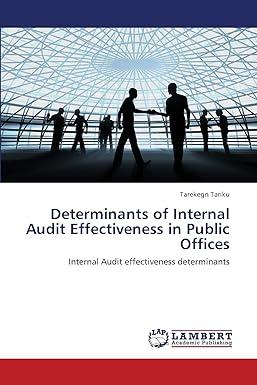Question
1. Jerry purchased a U.S. Series EE savings bond for $279. The bond has a maturity value in 10 years of $500 and yields 6%
1. Jerry purchased a U.S. Series EE savings bond for $279. The bond has a maturity value in 10 years of $500 and yields 6% interest. This is the first Series EE bond that Jerry has ever owned.
a. Jerry must report the interest income each year using the original issue discount rules.
b. Jerry can report all of the $221 interest income in the year the bond matures.
c. The interest on the bonds is exempt from Federal income tax.
d. Jerry must report one tenth of the interest income each year he owns the bond.
2. Home Office, Inc., leased a copying machine to a new customer on December 27, 2016. The machine was to rent for $500 per month for a period of 36 months beginning January 1, 2017. The customer was required to pay the first and last months rent plus an $800 damage deposit at the time the lease was signed (December 27, 2016). Home Office must recognize as income for the lease:
a. $1,000 in 2016, if Home Office is an accrual basis taxpayer.
b. $1,000 in 2017, if Home Office is a cash basis taxpayer.
c. $1,800 in 2016, if Home Office is an accrual basis taxpayer
d. $0 in 2016.
3. With respect to the prepaid income from services, which one of the following is true?
a. The treatment of prepaid income is the same for tax and financial accounting.
b. A cash basis taxpayer can spread the income over the period services are to be provided if all of the services will be completed by the end of the tax year following the year of receipt.
c. An accrual basis taxpayer can defer the portion of the advance payment that relates to services not to be provided in the current tax year to the next tax year (the tax year after the year of receipt of the advance payment).
d. An accrual basis taxpayer can spread the income over the period services are to be provided regardless of the length of that period.
4. Teal Company is an accrual basis taxpayer. On December 1, 2016, a customer paid for a particular item that was on hand, but the customer wanted the item delivered in early January. Teal delivered the item on January 4, 2017.
a. Teal must recognize the income in 2016.
b. Teal may recognize the income in 2017 if Teal also does so for financial reporting purposes.
c. Teal can elect to recognize the income in either 2016 or 2017.
d. Teal must recognize 1/12th of the sale price as income in 2016 and the remainder in 2017.
5. On January 5, 2016, Jane purchased a corporate bond paying interest at 8% for $30,000. On September 1, 2016, she gave the bond to Tim. The bond pays $2,400 interest on December 31st. Jane and Tim are cash basis taxpayers. When Tim collects the interest in December 2016:
a. Jane must include all of the interest in her gross income.
b. Tim must include all of the interest in his gross income.
c. Jane must report $1,600 interest income in 2016, and Tim must report $800 interest income in 2016.
d. Jane must report $800 and Tim must report $1,600 interest income in 2016.
6. Hubert contracted with Silver Company, Huberts controlled C-corporation. Hubert was a medical doctor and the contract provided that he would work exclusively for the corporation. No other doctor worked for the corporation. The corporation contracted to perform an operation for Paula for $1,800. The corporation paid Hubert $1,200 to perform the operation under the terms of his employment contract.
a. Hubert must recognize $1,800 gross income on his personal tax return.
b. Hubert must recognize $600 taxable income on his personal tax return.
c. Huberts gross income is $1,200.
d. Hubert recognizes no gross income related to these events.
7. Daryl, a cash basis taxpayer, gave 1,000 shares of Copper Company common stock to his daughter on September 29, 2016. Copper Company is a publicly held company that has declared a $1.00 per share dividend on September 30th every year for the last 20 years. Just as Daryl had expected, Copper Company declared a $1.00 per share dividend on September 30, 2016, payable on October 15th, to stockholders of record as of October 10th. The daughter received the $1,000 dividend on October 18, 2016.
a. Daryl must recognize the $1,000 dividend as his income because he knew the dividend would be paid when he gifted the stock.
b. Daryl must recognize $750 of the dividend because he owned the stock for three- fourths of the year.
c. Daryl must recognize the $1,000 dividend because he still constructively owns the stock.
d. Daryl will recognize none of the $1,000 dividend.
Step by Step Solution
There are 3 Steps involved in it
Step: 1

Get Instant Access to Expert-Tailored Solutions
See step-by-step solutions with expert insights and AI powered tools for academic success
Step: 2

Step: 3

Ace Your Homework with AI
Get the answers you need in no time with our AI-driven, step-by-step assistance
Get Started


